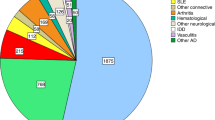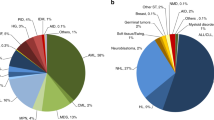Abstract
Hematopoietic stem cells (HSCs) have the capacity for self-renewal and the potential to differentiate into all types of hematopoietic and immune system cells. These features have been successfully used to treat a multitude of hematologic malignancies and nonmalignant diseases such as aplastic anemia, hemoglobinopathies, inborn errors of metabolism and congenital immunodeficiency states. The application of HSC transplantation has been expanded over the past decade to include immune-mediated diseases such as multiple sclerosis, treatment-refractory rheumatoid arthritis, systemic lupus erythematosus and systemic sclerosis. Transplantation of HSCs for the treatment of autoimmune diseases aims to fundamentally correct the dysregulated immune system, which could result in sustained clinical remission or potential cure. The use of this approach is currently restricted to clinical research, as there is no standard conditioning regimen to attain these aims in autoimmune diseases. HSC transplantation is associated with inherent morbidity and mortality, both treatment-related and disease-related, and selecting the correct group of patients with the best risk:benefit ratio is a challenging task.
Key Points
-
Hematopoietic stem cell transplantation (HSCT) is a potential treatment option for patients with autoimmune disease
-
Defining the eligibility criteria for patient selection with optimal risk:benefit ratio remains a challenge
-
Early referral for consultation to experienced transplant centers of patients who are not critically ill but who have aggressive, refractory autoimmune disease is essential to improve outcomes
-
To assess efficacy and safety, the outcome measures in HSCT trials for autoimmune disease must be well defined
-
HSCT studies in autoimmune diseases must be coupled with basic research to understand the fundamental immunologic changes that occur during this treatment
This is a preview of subscription content, access via your institution
Access options
Subscribe to this journal
Receive 12 print issues and online access
$209.00 per year
only $17.42 per issue
Buy this article
- Purchase on Springer Link
- Instant access to full article PDF
Prices may be subject to local taxes which are calculated during checkout

Similar content being viewed by others
References
Copelan EA (2006) Hematopoietic stem-cell transplantation. N Engl J Med 354: 1813–1826
Appelbaum FR (2007) Hematopoietic-cell transplantation at 50. N Engl J Med 357: 1472–1475
Voltarelli JC et al. (2007) Autologous nonmyeloablative hematopoietic stem cell transplantation in newly diagnosed type 1 diabetes mellitus. JAMA 297: 1568–1576
Sykes M and Nikolic B (2005) Treatment of severe autoimmune disease by stem-cell transplantation. Nature 435: 620–627
Bekkum DW (2000) Immune ablation and stem-cell therapy in autoimmune disease. Experimental basis for autologous stem-cell transplantation. Arthritis Res 2: 281–284
van Bekkum DW (2000) Stem cell transplantation in experimental models of autoimmune disease. J Clin Immunol 20: 10–16
Lipsky PE (2001) Systemic lupus erythematosus: an autoimmune disease of B cell hyperactivity. Nat Immunol 2: 764–766
Shlomchik MJ et al. (2001) From T to B and back again: positive feedback in systemic autoimmune disease. Nat Rev Immunol 1: 147–153
Muraro PA and Douek DC (2006) Renewing the T cell repertoire to arrest autoimmune aggression. Trends Immunol 27: 61–67
Muraro PA et al. (2005) Thymic output generates a new and diverse TCR repertoire after autologous stem cell transplantation in multiple sclerosis patients. J Exp Med 201: 805–816
Chen X et al. (2007) Absence of regulatory T cell control of TH1 and TH17 cells is responsible for the autoimmune-mediated pathology in chronic graft versus host disease. Blood 110: 3804–3813
Laurence A and O'Shea JJ (2007) T(H)-17 differentiation: of mice and men. Nat Immunol 8: 903–905
Zorina TD et al. (2003) Recovery of the endogenous beta cell function in the NOD model of autoimmune diabetes. Stem Cells 21: 377–388
Griffith LM et al. (2005) Feasibility of allogeneic hematopoietic stem cell transplantation for autoimmune disease: position statement from a National Institute of Allergy and Infectious Diseases and National Cancer Institute-Sponsored International Workshop, Bethesda, MD, March 12 and 13, 2005. Biol Blood Marrow Transplant 11: 862–870
Lu Q et al. (2006) Non-myeloablative allogeneic stem cell transplant in a patient with refractory systemic lupus erythematosus. Bone Marrow Transplant 37: 979–981
Muraro PA et al. (2006) Granulocytic invasion of the central nervous system after hematopoietic stem cell transplantation for systemic lupus erythematosus. Haematologica 91: ECR21
Brinkman DM et al. (2007) Resetting the adaptive immune system after autologous stem cell transplantation: lessons from responses to vaccines. J Clin Immunol 27: 647–658
Storb RF et al. (2003) Hematopoietic cell transplantation for benign hematological disorders and solid tumors. Hematology Am Soc Hematol Educ Program 2003: 372–397
de Kleer I et al. (2006) Autologous stem cell transplantation for autoimmunity induces immunologic self-tolerance by reprogramming autoreactive T cells and restoring the CD4+CD25+ immune regulatory network. Blood 107: 1696–1702
Avanzini MA et al. (2005) B lymphocyte reconstitution after hematopoietic stem cell transplantation: functional immaturity and slow recovery of memory CD27+ B cells. Exp Hematol 33: 480–486
Loh Y et al. (2007) Development of a secondary autoimmune disorder after hematopoietic stem cell transplantation for autoimmune diseases: role of conditioning regimen used. Blood 109: 2643–2548
Daikeler T and Tyndall A (2007) Autoimmunity following haematopoietic stem-cell transplantation. Best Pract Res Clin Haematol 20: 349–360
Gratwohl A et al. (2005) Autologous hematopoietic stem cell transplantation for autoimmune diseases. Bone Marrow Transplant 35: 869–879
Urowitz MB et al. (1997) Mortality studies in systemic lupus erythematosus. Results from a single center. III. Improved survival over 24 years. J Rheumatol 24: 1061–1065
Burt RK et al. (2006) Nonmyeloablative hematopoietic stem cell transplantation for systemic lupus erythematosus. JAMA 295: 527–535
Jayne D et al. (2004) Autologous stem cell transplantation for systemic lupus erythematosus. Lupus 13: 168–176
Snowden JA et al. (2004) Autologous hemopoietic stem cell transplantation in severe rheumatoid arthritis: a report from the EBMT and ABMTR. J Rheumatol 31: 482–488
Burt RK et al. (2004) Induction of remission of severe and refractory rheumatoid arthritis by allogeneic mixed chimerism. Arthritis Rheum 50: 2466–2470
Brinkman DM et al. (2007) Autologous stem cell transplantation in children with severe progressive systemic or polyarticular juvenile idiopathic arthritis: long-term follow-up of a prospective clinical trial. Arthritis Rheum 56: 2410–2421
Steen VD and Medsger TA Jr (2000) Severe organ involvement in systemic sclerosis with diffuse scleroderma. Arthritis Rheum 43: 2437–2444
Mayes MD et al. (2003) Prevalence, incidence, survival, and disease characteristics of systemic sclerosis in a large US population. Arthritis Rheum 48: 2246–2255
Hoyles RK et al. (2006) A multicenter, prospective, randomized, double-blind, placebo-controlled trial of corticosteroids and intravenous cyclophosphamide followed by oral azathioprine for the treatment of pulmonary fibrosis in scleroderma. Arthritis Rheum 54: 3962–3970
Tashkin DP et al. (2006) Cyclophosphamide versus placebo in scleroderma lung disease. N Engl J Med 354: 2655–2666
Nash RA et al. (2007) High-dose immunosuppressive therapy and autologous hematopoietic cell transplantation for severe systemic sclerosis: long-term follow-up of the US multicenter pilot study. Blood 110: 1388–1396
Farge D et al. (2004) Autologous stem cell transplantation in the treatment of systemic sclerosis: report from the EBMT/EULAR Registry. Ann Rheum Dis 63: 974–981
Oyama Y et al. (2007) Autologous non-myeloablative hematopoietic stem cell transplantation in patients with systemic sclerosis. Bone Marrow Transplant 40: 549–555
The ASTIS trial [http://www.astistrial.com/] (accessed 14 January 2008)
The SCOT trial [http://www.clinicaltrials.gov/ct2/show/NCT00114530?term=NCT00114530& rank=1] (accessed 14 January 2008)
The ASSIST trial [http://www.clinicaltrials.gov/ct2/show/NCT00278525?term=00278525& rank=1] (accessed 14 January 2008)
van Laar JM et al. (2005) Autologous Stem cell Transplantation International Scleroderma (ASTIS) trial: hope on the horizon for patients with severe systemic sclerosis. Ann Rheum Dis 64: 1515
Burt RK et al. (2005) Hematopoietic stem cell transplantation for multiple sclerosis. Arch Neurol 62: 860–864
Nash RA et al. (2003) High-dose immunosuppressive therapy and autologous peripheral blood stem cell transplantation for severe multiple sclerosis. Blood 102: 2364–2372
Saccardi R et al. (2006) Autologous stem cell transplantation for progressive multiple sclerosis: update of the European Group for Blood and Marrow Transplantation autoimmune diseases working party database. Mult Scler 12: 814–823
Daikeler T et al. (2007) Haematopoietic stem cell transplantation for vasculitis including Behcet's disease and polychondritis: a retrospective analysis of patients recorded in the European Bone Marrow Transplantation and European League Against Rheumatism databases and a review of the literature. Ann Rheum Dis 66: 202–207
Statkute L et al. (2007) Autologous non-myeloablative hematopoietic stem cell transplantation for refractory systemic vasculitis. Ann Rheum Dis [doi:10.1136/ard.2007.070227]
Burt RK et al. (2006) Randomized controlled trials of autologous hematopoietic stem cell transplantation for autoimmune diseases: the evolution from myeloablative to lymphoablative transplant regimens. Arthritis Rheum 54: 3750–3760
Tyndall A et al. (2007) Immunomodulatory properties of mesenchymal stem cells: a review based on an interdisciplinary meeting held at the Kennedy Institute of Rheumatology Division, London, UK, 31 October 2005. Arthritis Res Ther 9: 301
Tisato V et al. (2007) Mesenchymal stem cells of cord blood origin are effective at preventing but not treating graft-versus-host disease. Leukemia 21: 1992–1999
Dazzi F et al. (2007) Cell therapy for autoimmune diseases. Arthritis Res Ther 9: 206
Acknowledgements
We would like to thank GG Illei and I Alevizos for their critical review and suggestions on the manuscript.
Author information
Authors and Affiliations
Corresponding author
Ethics declarations
Competing interests
The authors declare no competing financial interests.
Rights and permissions
About this article
Cite this article
Nikolov, N., Pavletic, S. Technology Insight: hematopoietic stem cell transplantation for systemic rheumatic disease. Nat Rev Rheumatol 4, 184–191 (2008). https://doi.org/10.1038/ncprheum0756
Received:
Accepted:
Published:
Issue Date:
DOI: https://doi.org/10.1038/ncprheum0756
This article is cited by
-
Changes in the Number of CD8+ T Lymphocytes in the Peripheral Blood of Patients with Various Autoimmune Diseases after Autologous Hematopoietic Stem Cell Transplantations and their Relations to the Survival Times
Archivum Immunologiae et Therapiae Experimentalis (2013)
-
Long-lived autoreactive plasma cells drive persistent autoimmune inflammation
Nature Reviews Rheumatology (2011)
-
Targeted therapy for systemic sclerosis: how close are we?
Nature Reviews Rheumatology (2010)



